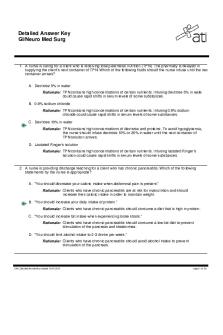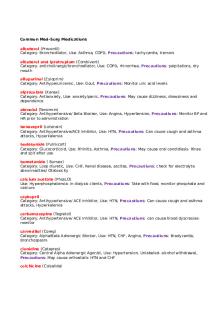GI Meds - ergwgq PDF

| Title | GI Meds - ergwgq |
|---|---|
| Course | nursing |
| Institution | West Coast University |
| Pages | 3 |
| File Size | 120.7 KB |
| File Type | |
| Total Downloads | 32 |
| Total Views | 153 |
Summary
ergwgq...
Description
1
GI Medications
Gastrointestinal Medications Classification Antacids
Mechanism (Pharmacology) Neutralizes gastric acids, increases serum bicarbonate (raises pH), or binds to intestinal phosphates
Action (What it Really Does) Raises the pH in the GI tract by either increasing HCO3 from the kidneys or decreasing / neutralizing the HCL acid released by stomach
Examples Aluminum Hydroxide (Amphogel); Maalox, Mylanta (Aluminum hydroxide/magnesium hydroxide/simethicone), Titralac, Alternagel, Calcium Carbonate (TUMS, Maalox), Sodium Bicarbonate
Proton Pump Inhibitors (PPI)
Inhibits gastric acid (gastrin) production and secretion at the level of parietal cells in the stomach
Reduces acid secretion in the stomach therefore helps ulcers heal and prevents further gastric ulcer formation.
Omeprazole (Prilosec), Pantoprazole (Protonix),
Antisecretory Agent Prostaglandin E Analog Gastric Mucosal Protectant
Inhibits gastric acid secretion and protects gastric mucosa
Eliminates gastric acid, therefore protects mucosa from damage
Misoprostol (Cytotec)
Adheres to site of ulcerations in order to prevent further breakdown
Helps to heal and protect gastric mucosa by adhering to surface
Sucralfate (Carafate)
Histamine Blockers (H2)
Selectively antagonizes histamine H2 receptors to block gastric acid secretions
Reduces gastric acids by blocking histamine receptors (histamine is normally released to block unwanted “invaders”….therefore increases acidity).
Ranitidine (Zantac), Famotidine (Pepcid), Cimetidine (Tagamet), Nizatidine (Axid)
Aminosalicylates
Reduces prostaglandin synthesis to reduce inflammation
Helps reduce inflammation in the GI tract and elsewhere, thereby helping prevent flare-ups in diseases such as Crohn’s and Ulcerative Colitis
Sulfasalazine (Azulfidine), Olsalazine (Dipenturn), Mesalamine (Rowasa, Asacol)
Emetic
Stimulates the CNS to induce vomiting
Induces vomiting for therapeutic benefit
Sorbitol, Ipecac
2
Antiemetic
Antagonizes acetylcholine receptors
GI Medications
Medications all work on the central >>>> nervous system by blocking receptors to neurotransmitters (promotes anticholinergic responses)
Antagonizes H1 receptors in nervous >>>>>>>>>>>>>>>>>>>>>>>>>>>>>> system
Antidiarrheals
Promethazine (Phenergan), Dimenhydrinate (Dramamine)
Selectively antagonizes Serotonin 5HT3 receptors
>>>>>>>>>>>>>>>>>>>>>>>>>>>>>>
Ondansetron (Zofran), Dolasetron (Anzemet)
Sensitizes tissues to acetylcholine, stimulating upper GI tract motility; antagonizes dopamine receptors
>>>>>>>>>>>>>>>>>>>>>>>>>>>>>> **Very important nursing consideration for all antiemetics is to monitor for sedation as anything that works in CNS may cause oversedation.
Metoclopramide (Reglan), Trimethobenzamide (Tigan)
Binds to gut wall opioid receptor, inhibiting peristalsis; increases anal sphincter tone
All medications in this classification >>> reduce peristalsis and gastric secretions to increase the time stool spends in the GI tract. >>>>>>>>>>>>>>>>>>>>>>>>>>>>>>
Loperamide (Imodium), Diphenoxylate/Atropine (Lomotil),
Reduces gastric secretions and possesses topical mucosal effects
Bismuth may turn stools dark – which >> may be misinterpreted as GI bleeding. Check stools for OB to make sure.
Bismuth Subsalicylate (Kopectate, Pepto-Bismol)
Alters gas bubble surface tension
Reduces flatulence. Especially useful in hypermotility disorders
Simethicone (Mylicon, Phazyme, Gas-X)
Binds intestinal bile acids
Antiflatulents
Meclizine (Antivert), Prochlorperazine Maleate (Compazine), Scopolamine (Scopace)
Colestipol (Colestid), Cholestyramine (Questran, Prevalite)
3
Laxatives Bulk Laxative
GI Medications
Increases stool bulk
All forms of laxatives are used to relieve constipation and produce normal stools.
Psyllium (Metamucil), Methylcellulose (Citrucel)
Stimulant Laxative
Increases peristalsis in GI tract
All forms of laxatives do have the potential for abuse and also diarrhea
Bisacodyl (Dulcolax), Castor Oil, Sennoside (Ex-lax, Senna)
Osmotic Laxative
Neutralizes gastric acidity and causes water retention in stool which produces laxative effect
Milk of Magnesia, Lactulose, Plythylene glycol (MiraLax)
Stool Softener
Facilitates mixture of stool fat and water Antagonizes acetylcholine at muscarinic receptors, relaxes smooth muscles, and inhibits histamineinduced spasms
Ducusate Sodium (Colace)
Antispasmodics
Reduces GI motility by relaxing smooth muscles in intestines, especially in times of stress (anticholinergic action). Useful with IBS to reduce frequency and urgency
Dicyclomine (Bentyl), Hyoscyamine (Anaspaz, Levsin), or Donnatol (combination of hyoscyamine, atropine, scopolamine, and phenobarbital)...
Similar Free PDFs

GI Meds - ergwgq
- 3 Pages

Ben Bundy meds - meds
- 2 Pages

SIM meds
- 4 Pages

Dosage Calculation - Oral Meds
- 2 Pages

Clinical Meds ICU - medications
- 4 Pages

GI Adpie
- 5 Pages

Ati gi med surg - Gi study guide
- 53 Pages

NSG 307 Meds - medications
- 15 Pages

GI system Study Guide - GI REVIEW
- 35 Pages

Eye meds Admin/assessment
- 5 Pages

GI Case 45-1 - GI case study
- 6 Pages

Chapter 57 Cardiac Meds Sheet
- 3 Pages

Ob-meds-mo nurs 306
- 9 Pages

Common Med Surg Meds
- 7 Pages
Popular Institutions
- Tinajero National High School - Annex
- Politeknik Caltex Riau
- Yokohama City University
- SGT University
- University of Al-Qadisiyah
- Divine Word College of Vigan
- Techniek College Rotterdam
- Universidade de Santiago
- Universiti Teknologi MARA Cawangan Johor Kampus Pasir Gudang
- Poltekkes Kemenkes Yogyakarta
- Baguio City National High School
- Colegio san marcos
- preparatoria uno
- Centro de Bachillerato Tecnológico Industrial y de Servicios No. 107
- Dalian Maritime University
- Quang Trung Secondary School
- Colegio Tecnológico en Informática
- Corporación Regional de Educación Superior
- Grupo CEDVA
- Dar Al Uloom University
- Centro de Estudios Preuniversitarios de la Universidad Nacional de Ingeniería
- 上智大学
- Aakash International School, Nuna Majara
- San Felipe Neri Catholic School
- Kang Chiao International School - New Taipei City
- Misamis Occidental National High School
- Institución Educativa Escuela Normal Juan Ladrilleros
- Kolehiyo ng Pantukan
- Batanes State College
- Instituto Continental
- Sekolah Menengah Kejuruan Kesehatan Kaltara (Tarakan)
- Colegio de La Inmaculada Concepcion - Cebu

